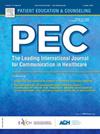Education in foot care using dialogic learning or conversation maps for people with diabetes
IF 2.9
2区 医学
Q2 PUBLIC, ENVIRONMENTAL & OCCUPATIONAL HEALTH
引用次数: 0
Abstract
Objective
To compare the efficacy of two educational strategies for improving knowledge, attitudes, and practices regarding foot care among individuals with diabetes: traditional education with dialogic learning and conversation maps.
Methods
A controlled pre- and post-test quasi-experimental design was employed. Group 1 received education with dialogic learning, while Group 2 received education with conversation maps. All participants completed a questionnaire on their knowledge, attitudes, and practices before and after the educational intervention. The statistical test measured the difference in means.
Results
A total of 140 individuals participated, with 42 (30 %) in Group 1 and 98 (70 %) in Group 2. Both groups had significantly more correct answers after than before the intervention (mean: 14.2–26.6, Wilcoxon paired test, p = 0.01).
The increase in correct answers after the intervention was more pronounced in the group using dialogic learning than in the group using conversation maps (mean difference in correct answers of Group 1 vs. Group 2: 14.6 vs. 11.5; Wilcoxon paired test, p = 0.005).
Conclusions
Improved results were observed for both educational strategies after the intervention. Dialogic learning was more effective than conversation maps in improving knowledge, attitudes, and practices related to foot care.
Practical implications
Structured, community-based education using dialogic learning or conversation maps may enhance self-care and prevent foot complications in people with diabetes.
利用对话学习或对话图对糖尿病患者进行足部保健教育
目的比较两种教育策略在改善糖尿病患者足部护理知识、态度和实践方面的效果:传统的对话学习教育和对话地图教育。方法采用前后对照准实验设计。第一组采用对话学习,第二组采用对话图学习。所有参与者在教育干预前后完成了一份关于他们的知识、态度和行为的调查问卷。统计检验测量了平均值的差异。结果共140例患者,其中1组42例(30 %),2组98例(70 %)。干预后两组的正确率均显著高于干预前(平均值:14.2 ~ 26.6,Wilcoxon配对检验,p = 0.01)。使用对话学习的组在干预后正确答案的增加比使用对话图的组更明显(第一组与第二组正确答案的平均差异:14.6 vs 11.5;Wilcoxon配对检验,p = 0.005)。结论干预后两种教育策略的效果均有改善。对话学习在改善足部护理的知识、态度和实践方面比对话地图更有效。实际意义采用对话学习或对话图的结构化社区教育可以增强糖尿病患者的自我保健和预防足部并发症。
本文章由计算机程序翻译,如有差异,请以英文原文为准。
求助全文
约1分钟内获得全文
求助全文
来源期刊

Patient Education and Counseling
医学-公共卫生、环境卫生与职业卫生
CiteScore
5.60
自引率
11.40%
发文量
384
审稿时长
46 days
期刊介绍:
Patient Education and Counseling is an interdisciplinary, international journal for patient education and health promotion researchers, managers and clinicians. The journal seeks to explore and elucidate the educational, counseling and communication models in health care. Its aim is to provide a forum for fundamental as well as applied research, and to promote the study of organizational issues involved with the delivery of patient education, counseling, health promotion services and training models in improving communication between providers and patients.
 求助内容:
求助内容: 应助结果提醒方式:
应助结果提醒方式:


